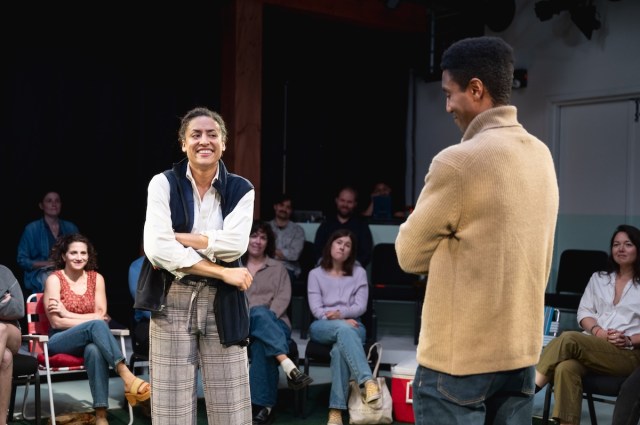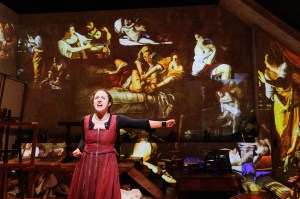Review: A Woman Among Women Breaks in the New Bushwick Starr
Julia May Jonas’s drama makes its world premiere on Eldert Street.

(© Valerie Terranova)
It took me a while to connect with A Woman Among Women, the new drama by Julia May Jonas, now making its world premiere as the inaugural production of the permanent home of the Bushwick Starr (the theater looks great, by the way). Coproduced with New Georges and inspired by Arthur Miller’s All My Sons, it transposes the themes of respect, regret, and accountability to ultra-progressive Northampton, Massachusetts — and perhaps more notably to a society dominated by women — in ways that are illuminating, provocative, and too often needlessly bewildering.
The latter adjective entirely derives from director Sarah Hughes’s immersive and somewhat chaotic staging, which assembles the audience in two concentric rings. The actors sit on lawn chairs next to audience members in the inner ring, which conjures both a yard party and group therapy (in fairness to Hughes, Jonas demands as much in her script). The choice is likely inspired by our protagonist’s vocation.
Cleo (a disarmingly jovial Dee Pelletier) is a psychologist who founded a psychological wellness center for women in Northampton. “The house was 79 in ’81,” she brags in her very first line. “Now it’s worth / I don’t know / 6? 650?” A clear winner in the generational housing wars, she is doubly blessed to be surrounded by a large and loving community.
There’s her neighbor and coworker Sarah (Hannah Heller) and Sarah’s husband Lane (Drew Lewis). There’s also the lesbian couple next door, Christine (Brittany K. Allen) and Tammy (Lucy Kaminsky). And let’s not forget little Rida (Annie Fang convincingly portrays both an 8-year-old and later, a woman in her 60s, although neither character adds much to the proceedings).

(© Valerie Terranova)
This is the house where Cleo raised her daughters, Jo and Grace (Zoë Geltman), with the help of Tina (Maria-Christina Oliveras), a non-romantic co-parent. They’re all abuzz with the imminent arrival of Roy (Gabriel Brown), Jo’s husband, whom Cleo describes as “filled out” and “wolfish” (Brown looks nothing of the sort, but delivers an emotionally engaging performance nonetheless).
The chime of a glockenspiel heralds the arrival of each new character, perhaps in a Pavlovian attempt to get us to internalize this barrage of new information (it didn’t work on me, and I was quite relieved to have a digital program and script when I sat down to write this review). It’s doubly confusing as Wendy Yang’s costumes are a hyper-authentic representation of the aggressively twee fashion choices of the American creative class. As the characters sit among the audience, it’s difficult to discern where the fictional hipsters end and the real ones begin.
While it might replicate the feeling of being in an AA meeting, Jonas and Hughes’s explosion of names and faces proves to not be strictly necessary, as not every character is essential to the plot. It’s the kind of largesse that could only come from a novelist grown accustomed to the sprawl (Jonas is the author of the excellent novel Vladimir, not to be confused with the recently opened off-Broadway play).
The central conflict involves Cleo’s eldest, Jo, who is bipolar with aggressive tendencies. In a fit of road rage, she beat an elderly man until he could no longer walk — and now she is incarcerated (the character does not appear in the play). Cleo and Roy absolutely think she belongs in prison, but Tina is not so sure. She suspects Jo might have been off her meds, and this suspicion turns to apoplexy when it is revealed that Cleo was tampering with the drugs for fear of what lithium might do to Jo’s unborn child. It’s a livewire situation as laden with taboos as a story about war profiteering circa 1946. Unfortunately, that only comes into focus in the final third of the play, after the creatives have abandoned their initial staging concept.

(© Valerie Terranova)
It seems only appropriate that the immersive segment of the play should collapse in a burst of frenetic activity, like a universe imploding. Lewis leads the audience in a rhythm game as the other actors rearrange the spectators in a more traditional seating configuration. Audience members struggle to clap and slap their thighs to the beat as we move around. And then suddenly, the house lights dim and theatrical lights (competently plotted by Masha Tsimring) come up on a proscenium stage featuring a flimsy porch (scenic design by Brittany Vasta). It looks like a community theater production of All My Sons, and it’s the most riveting section of the play. As a statement about the efficacy of traditional versus experiential staging, it is a particularly convincing transformation — although I’m not sure it does much for the play.
The same can be said for Brian Cavanagh-Strong’s original music, which inserts an element of Brechtian whimsy into the proceedings as the characters sing about or tuberculosis or the enduring appeal of bad boys. The audience giggles, but it’s hard to receive these moments as anything more than winking comic relief. Cavanagh-Strong also provided original music for Jonas’s Your Own Personal Exegesis, a much tighter play that still had its quirks and superfluous curlicues.
While A Woman Among Women is a bit of a miss, it’s clear that Jonas has a nose for the drama lurking within the cracks of liberal American society. She also knows how to turn a phrase (“tight little ass-clenching anger” and “our no-god Church” are stand-outs in this script). If she could let go of her addiction to fruitless experimental theater cliches, I’m certain she could write a truly great American play.











